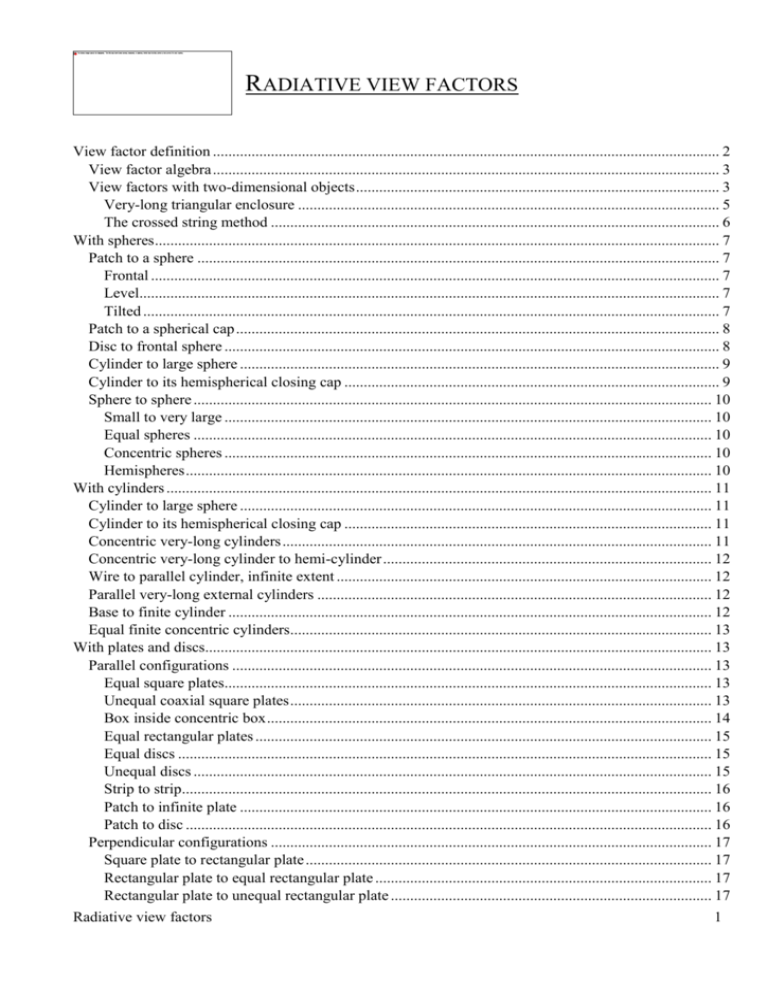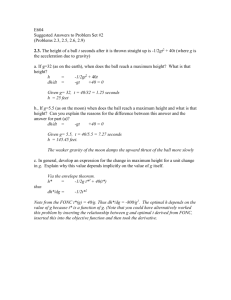Radiative View Factors: Definition, Algebra, and Geometries
advertisement

RADIATIVE VIEW FACTORS View factor definition ................................................................................................................................... 2 View factor algebra ................................................................................................................................... 3 View factors with two-dimensional objects .............................................................................................. 3 Very-long triangular enclosure ............................................................................................................. 5 The crossed string method .................................................................................................................... 6 With spheres .................................................................................................................................................. 7 Patch to a sphere ....................................................................................................................................... 7 Frontal ................................................................................................................................................... 7 Level...................................................................................................................................................... 7 Tilted ..................................................................................................................................................... 7 Patch to a spherical cap ............................................................................................................................. 8 Disc to frontal sphere ................................................................................................................................ 8 Cylinder to large sphere ............................................................................................................................ 9 Cylinder to its hemispherical closing cap ................................................................................................. 9 Sphere to sphere ...................................................................................................................................... 10 Small to very large .............................................................................................................................. 10 Equal spheres ...................................................................................................................................... 10 Concentric spheres .............................................................................................................................. 10 Hemispheres ........................................................................................................................................ 10 With cylinders ............................................................................................................................................. 11 Cylinder to large sphere .......................................................................................................................... 11 Cylinder to its hemispherical closing cap ............................................................................................... 11 Concentric very-long cylinders ............................................................................................................... 11 Concentric very-long cylinder to hemi-cylinder ..................................................................................... 12 Wire to parallel cylinder, infinite extent ................................................................................................. 12 Parallel very-long external cylinders ...................................................................................................... 12 Base to finite cylinder ............................................................................................................................. 12 Equal finite concentric cylinders............................................................................................................. 13 With plates and discs................................................................................................................................... 13 Parallel configurations ............................................................................................................................ 13 Equal square plates.............................................................................................................................. 13 Unequal coaxial square plates ............................................................................................................. 13 Box inside concentric box ................................................................................................................... 14 Equal rectangular plates ...................................................................................................................... 15 Equal discs .......................................................................................................................................... 15 Unequal discs ...................................................................................................................................... 15 Strip to strip......................................................................................................................................... 16 Patch to infinite plate .......................................................................................................................... 16 Patch to disc ........................................................................................................................................ 16 Perpendicular configurations .................................................................................................................. 17 Square plate to rectangular plate ......................................................................................................... 17 Rectangular plate to equal rectangular plate ....................................................................................... 17 Rectangular plate to unequal rectangular plate ................................................................................... 17 Radiative view factors 1 Strip to strip......................................................................................................................................... 18 Tilted strip configurations ....................................................................................................................... 18 Equal adjacent strips ........................................................................................................................... 18 Triangular prism .................................................................................................................................. 18 Numerical computation ............................................................................................................................... 19 References ................................................................................................................................................... 20 VIEW FACTOR DEFINITION The view factor F12 is the fraction of energy exiting an isothermal, opaque, and diffuse surface 1 (by emission or reflection), that directly impinges on surface 2 (to be absorbed, reflected, or transmitted). View factors depend only on geometry. Some view factors having an analytical expression are compiled below. We will use the subindices in F12 without a separator when only a few single view-factors are concerned, although more explicit versions, like F1,2 , or even better, F1→2, could be used. From the above definition of view factors, we get the explicit geometrical dependence as follows. Consider two infinitesimal surface patches, dA1 and dA2 (Fig. 1), in arbitrary position and orientation, defined by their separation distance r12, and their respective tilting relative to the line of centres, 1 and 2, with 01/2 and 02/2 (i.e. seeing each other). The expression for dF12 (we used the differential symbol ‘d’ to match infinitesimal orders of magnitude, since the fraction of the radiation from surface 1 that reaches surface 2 is proportional to dA2), in terms of these geometrical parameters is as follows. The radiation power intercepted by surface dA2 coming directly from a diffuse surface dA1 is the product of its radiance L1=M1/, times its perpendicular area dA1, times the solid angle subtended by dA2, d12; i.e. d212=L1dA1d12=L1(dA1cos(1))dA2cos(2)/r122. Thence: dF12 L d d cos 1 cos 1 cos 1 d2 cos 2 cos 1 cos 2 d 212 1 12 1 d12 d2 M1d1 M1d1 r122 r122 (1) Fig. 1. Geometry for view-factor definition. When finite surfaces are involved, computing view factors is just a problem of mathematical integration (not a trivial one, except in simple cases). Notice that the view factor from a patch dA1 to a finite surface A2, is just the sum of elementary terms, whereas for a finite source, A1, the total view factor, being a fraction, is the average of the elementary terms, i.e. the view factor between finite surfaces A1 and A2 is: Radiative view factors 2 F12 1 A1 cos cos 1 2 d A dA1 2 r122 A1 A2 (2) Recall that the emitting surface (exiting, in general) must be isothermal, opaque, and Lambertian (a perfect diffuser for emission and reflection), and, to apply view-factor algebra, all surfaces must be isothermal, opaque, and Lambertian. Finally notice that F12 is proportional to A2 but not to A1. View factor algebra When considering all the surfaces under sight from a given one (let the enclosure have N different surfaces, all opaque, isothermal, and diffuse), several general relations can be established among the N2 possible view factors Fij, what is known as view factor algebra: Bounding. View factors are bounded to 0Fij≤1 by definition (the view factor Fij is the fraction of energy exiting surface i, that impinges on surface j). Closeness. Summing up all view factors from a given surface in an enclosure, including the possible self-view factor for concave surfaces, Fij 1 , because the same amount of radiation j emitted by a surface must be absorbed. Reciprocity. Noticing from the above equation that dAidFij=dAjdFji=(cosicosj/(rij2))dAidAj, it is deduced that Ai Fij A j F ji . Distribution. When two target surfaces (j and k) are considered at once, Fi , j k Fij Fik , based on area additivity in the definition. Composition. Based on reciprocity and distribution, when two source areas are considered together, Fi j ,k Ai Fik Aj Fjk Ai Aj . One should stress the importance of properly identifying the surfaces at work; e.g. the area of a square plate of 1 m in side may be 1 m2 or 2 m2, depending on our considering one face or the two faces. Notice that the view factor from a plate 1 to a plate 2 is the same if we are considering only the frontal face of 2 or its two faces, but the view factor from a plate 1 to a plate 2 halves if we are considering the two faces of 1, relative to only taking its frontal face. For an enclosure formed by N surfaces, there are N2 view factors (each surface with all the others and itself). But only N(N1)/2 of them are independent, since another N(N1)/2 can be deduced from reciprocity relations, and N more by closeness relations. For instance, for a 3-surface enclosure, we can define 9 possible view factors, 3 of which must be found independently, another 3 can be obtained from Ai Fij A j F ji , and the remaining 3 by F ij 1. j View factors with two-dimensional objects Consider two infinitesimal surface patches, dA1 and dA2, each one on an infinitesimal long parallel strip as shown in Fig. 2. The view factor dF12 is given by (1), where the distance between centres, r12, and the angles 1 and2 between the line of centres and the respective normals are depicted in the 3D view, but we want to put them in terms of the 2D parameters shown in Fig. 2b (the minimum distance a= x 2 y 2 , Radiative view factors 3 and the1 and2 angles when z=0, 10 and20), and the depth z of the dA2 location. The relationship are: r12= x 2 y 2 z 2 = a2 z 2 , cos1=cos10cos, with cos1=y/r12=(y/a)(a/r12), cos10=y/a, cos=a/r12, and cos2=cos20cos, therefore, between the two patches: dF12 cos 1 cos 2 r122 d2 a 2 cos 10 cos 20 r124 d2 a 2 cos 10 cos 20 a2 z 2 2 d2 (3) Fig. 2. Geometry for view-factor between two patches in parallel strips: a 3D sketch, b) profile view. Expression (3) can be reformulated in many different ways; e.g. by setting d2A2=dwdz, where the ‘d2’ notation is used to match differential orders and dw is the width of the strip, and using the relation ad10=cos20dw. However, what we want is to compute the view factor from the patch dA1 to the whole strip from z=∞ to z=∞, what is achieved by integration of (3) in z: d 2 F12 a 2 cos 10 cos 20 a2 z 2 2 dwdz dF12 d F 2 12 dz cos 10 cos 20 2a dw cos 10 2 d10 (4) For instance, approximating differentials by small finite quantities, the fraction of radiation exiting a patch of A1=1 cm2, that impinges on a parallel and frontal strip (10=20=0) of width w=1 cm separated a distance a=1 m apart is F12=s/(2a)=0.01/(2·1)=0.005, i.e. a 0.5 %. It is stressed again that the exponent in the differential operator ‘d’ is used for consistency in infinitesimal order. Now we want to know the view factor dF12 from an infinite strip dA1 (of area per unit length dw1) to an infinite strip dA2 (of area per unit length dw2), with the geometry presented in Fig. 2. It is clear from the infinity-extent of strip dA2 that any patch d2A1=dw1dz1 has the same view factor to the strip dA2, so that the average coincides with this constant value and, consequently, the view factor between the two strips is precisely given by (4); i.e. following the example presented above, the fraction of radiation exiting a long strip of w1=1 cm width, that impinges on a parallel and frontal strip (10=20=0) of width w2=1 cm separated a distance a=1 m apart is F12=w2/(2a)=0.01/(2·1)=0.005, i.e. a 0.5 %. Notice the difference in view factors between the two strips and the two patches in the same position as in Fig. 2b: using dA1 and dA2 in both cases, the latter is given by the general expression (1), which takes the form dF12=cos10cos20dA2/(a2), whereas in the two-strip case it is dF12=cos10cos20dA2/(2a). Radiative view factors 4 Very-long triangular enclosure Consider a long duct with the triangular cross section shown in Fig. 3. We may compute the view factor F12 from face 1 to face 2 (inside the duct) by double integration of the view factor from a strip of width dw1 in L1 to strip dw2 in L2; e.g. using de strip-to-strip view factor (4), the strip to finite band view factor is F12=cos10d10/2=(sin10endsin10start)/2, where 10start and 10end are the angular start and end directions subtended by the finite band 2 from infinitesimal strip 1. To be more explicit, let go on with two perpendicular bands, L1 and L2 (Fig. 3) with =90º; using Cartesian coordinates as in Fig. 2b, the above view factor from a generic strip 1 (at x) to the whole band at 2, becomes F12=(sin10endsin10start)/2=(1 x x2 L22 )/2, and, upon integration on x, we get the view factor from finite band 1 to finite band 2: F12=(1/ L1 )(1 x x2 L22 )dx/2= L1 L2 L12 L22 2 L1 , Fig. 3. Triangular enclosure. But it is not necessary to carry out integrations because all view factors in such an enclosure can be found by simple application of view-factor algebra presented above. To demonstrate it, we first establish the closure relation Fij 1 at each of the three nodes, noticing that for non-concave surfaces Fii=0; then j we multiply by their respective areas (in our case L1, L2, L3, by unit depth length); next, we apply some reciprocity relations, and finally perform de combination of equations as stated: 0 F12 F13 1 L1F12 L1F13 L1 F21 0 F23 1 L2 F21 L2 F23 L2 L1F12 L2 F23 L2 F31 F32 0 1 L3 F31 L3 F32 L3 L1F13 L2 F23 L3 L L2 L3 F12 1 2 L1 (5)+(6)(7) 2 L1 F12 L1 L2 L3 (5) (6) (7) (8) We see how easy it is now to recover the result for perpendicular bands of width L1 and L2, F12= L1 L2 L12 L22 2 L1 ; e.g. the view factor between equal perpendicular bands is F12= 2 2 2 , i.e. 29 % of the energy diffusively outgoing a long strip will directly reach an equal strip perpendicular and hinged to the former, with the remaining 71 % being directed to the other side 3 (lost towards the environment if L3 is just an opening). Even though we have implicitly assumed straight-line cross-sections (Fig. 3), the result (8) applies to convex triangles too (we only required Fii=0), using the real curvilinear lengths instead of the straight distances. As for concave bands, the best is to apply (8) to the imaginary straight-line triangle, and afterwards solve for the trivial enclosure of the real concave shape and its corresponding virtual straightline. For instance, if in our previous example of two equal perpendicular straight strips (F12= 2 2 2 ), we substitute these planar strips for equal concave semi-cylinders with the same end points, the new view Radiative view factors 5 factor between semi-cylinders is F12= 2 2 4 =0.146, i.e. now only 15 % of the radiations diffusively emanating from concave semi-cylinder 1 arrives directly to concave semi-cylinder 2, another 15 % impinges on its own surface (F11), and the remaining 70 % impinging on the third side, as before. Now we generalise this algebraic method of computing view factors in two-dimensional geometries to non-contact surfaces. The crossed string method For any two infinitely long bands, 1 and 2 (Fig. 4), one can also find all the view factors from simple algebraic relations as in the triangular enclosure before, extending the result (8) to: F12 L4 L5 L3 L6 crossed strings uncrossed strings 2L1 2 source string (9) Fig. 4. Sketch used to deduce F12 in the general case of two infinitely long bands. The result (9) is deduced by applying the triangular relation (8) to triangle 134 (shadowed in Fig. 4) and triangle 156, plus the closure relation to the quadrilateral 1326 (F13+F12+F16=1), namely: L1 L3 L4 2 L1 L4 L5 L3 L6 F12 1 F12 F12 L L6 L5 2 L1 F16 1 2 L1 F13 (10) This procedure to compute view factors in two-dimensional configurations is known as the crossed-string, first developed by H.C. Hottel in the 1950s. The extension to non-planar surfaces 1 and 2 is as already presented for triangular enclosures. A further extension is possible to cases where there are obstacles (two-dimensional, of course) partially protruding into sides 3 and/or 6 in the quadrilateral 1326 (Fig. 4); it suffices to account for the real curvilinear length of each string when stretched over the obstacles. Example 1. Find the view factor between two long parallel cylinders of equal radii R, separated a distance 2 2 R between centres, using the crossed-string method. Sol.: With this clever separation, angle in Fig. E1 happens to be =/4 (45º), making calculations simpler. We get F12 from (10) by substituting L1=2R (the source cylinder), L4 and L5 (the crossing strings) each by the length abcde, and L3 and L6 (the non-crossing strings) each by 2 2 R between. The length abcde is composed of arc ab, segment bc, and so on, which in our special Radiative view factors 6 case is ab=R=(/4)R bc=R, and abcde=2(ab+cd)=(/2)R+2R, and finally F12=(L4+L5L3L6)/(2L1)= (2abcde 4 2 R)/(4R)=(R+4R 4 2 R)/(4R) =1/4+(1 2 )/=0.12, as can be checked with the general expression for cylinders in the compilation following. Fig. E1. Sketch used to deduce F12 between two infinitely long parallel cylinders. WITH SPHERES Patch to a sphere Frontal Case From a small planar plate facing a sphere of radius R, at a distance H from centres, with hH/R. View factor F12 Plot 1 h2 (e.g. for h=2, F12=1/4) Level Case From a small planar plate level to a sphere of radius R, at a distance H from centres, with hH/R. View factor F12 Plot 1 1 x arctan 2 x h with x h2 1 1 2 2 ( F12 h1 h 1 ) 2 (e.g. for h=2, F12=0.029) Tilted Case Radiative view factors View factor Plot 7 -if ||</2arcsin(1/h) (i.e. hcos>1), From a small planar plate cos F12 2 tilted to a sphere of h radius R, at a distance H -if not, from centres, with 1 hH/R; the tilting angle F12 2 cos arccos y x sin 1 y 2 h is between the normal sin 1 y 2 and the line of centres. 1 arctan x with x h2 1, y x cot (e.g. for h=2 and =/4 (45º), F12=0.177) Patch to a spherical cap Case From a small planar plate facing a spherical cap subtending a half-cone angle (or any other surface subtending the same solid angle). View factor Plot F12 sin 2 (e.g. for =45º, F12=1/2) Notice that the case ‘patch to frontal sphere’ above, can be recovered in our case with max=arcsin(R/H). Disc to frontal sphere Case From a disc of radius R1 to a frontal sphere of radius R2 at a distance H between centres (it must be H>R1), with hH/R1 and r2R2/R1. View factor 1 2 F12 2r2 1 1 1 2 h Plot (e.g. for h=r2=1, F12=0.586) Radiative view factors 8 From a sphere of radius R1 to a frontal disc of radius R2 at a distance H between centres (it must be H>R1, but does not depend on R1), with hH/R2. 1 1 F12 1 2 1 1 2 h (e.g. for R2=H and R1≤H, F12=0.146) Cylinder to large sphere Case From a small cylinder (external lateral area only), at an altitude H=hR and tilted an angle , to a large sphere of radius R, is between the cylinder axis and the line of centres). View factor Coaxial (=0): arcsin s 1 s F12 2 1 h Plot 2h h 2 1 h Perpendicular (=/2): with s F12 1 1 h 4 2 xE x dx 1 x2 with elliptic integrals E(x). 0 Tilted cylinder: F12 1 arcsin 1 h 2 0 with sin 1 z 2 d d 2 0 z cos cos sin sin cos (e.g. for h=1 and any , F12=1/2) Cylinder to its hemispherical closing cap Case View factor F11 1 From a finite cylinder (surface 1) of radius R and height H, to its hemispherical closing cap (surface 2), with r=R/H. Let surface 3 be the base, and surface 4 the virtual base of the hemisphere. 2 , F12 F13 F14 Plot 4 1 1 , F22 , F23 , 4r 2 2 4r F31 , F32 1 , F34 1 2r 2r 2r F21 with 4r 2 1 1 r (e.g. for R=H, F11=0.38, F12=0.31, Radiative view factors 9 F21=0.31, F22=0.50, F23=0.19, F31=0.62, F32=0.38, F34=0.38) Sphere to sphere Small to very large Case From a small sphere of radius R1 to a much larger sphere of radius R2 at a distance H between centres (it must be H>R2, but does not depend on R1), with hH/R2. View factor F12 Plot 1 1 1 1 2 2 h (e.g. for H=R2, F12=1/2) Equal spheres Case From a sphere of radius R to an equal sphere at a distance H between centres (it must be H>2R), with hH/R. View factor F12 Plot 1 1 1 1 2 2 h (e.g. for H=2R, F12=0.067) Concentric spheres Case Between concentric spheres of radii R1 and R2>R1, with rR1/R2<1. View factor Plot F12=1 F21=r2 F22=1r2 (e.g. for r=1/2, F12=1, F21=1/4, F22=3/4) Hemispheres Case From a hemisphere of radius R (surface 1) to its base circle (surface 2). Radiative view factors View factor F21=1 F12=A2F21/A1=1/2 F11=1F12=1/2 Plot 10 F12 1 4 1 , F21 2 1 , 4 R 4 1 1 , F13 F22 1 2 , 2 R 1 1 F23 1 2 1 2 R 2 R2 1 From a hemisphere of radius R1 to a larger concentric hemisphere of radius R2>R1, with RR2/R1>1. Let the closing planar annulus be surface 3. , F31 2R 2 , F32 1 2 R 2 1 with 1 1 2 1 R 1 R 2 2 arcsin 2 R From a sphere of radius R1 to a larger concentric hemisphere of radius R2>R1, with RR2/R1>1. Let the enclosure be ‘3’. (e.g. for R=2, F12=0.93, F21=0.23, F13=0.07, F31=0.05, F32=0.95, F23=0.36,F22=0.41) F12=1/2, F13=1/2, F21=1/R2, 1 1 F23=1F21F22, F22 1 2 2 R with 1 1 1 R 2 1 R 2 2 arcsin 2 R (e.g. for R=2, F12=1/2, F21=1/4, F13=1/2, F23=0.34,F22=0.41) WITH CYLINDERS Cylinder to large sphere See results under Cases with spheres. Cylinder to its hemispherical closing cap See results under Cases with spheres. Concentric very-long cylinders Case Between concentric infinite cylinders of radii R1 and R2>R1, with rR1/R2<1. View factor Plot F12=1 F21=r F22=1r (e.g. for r=1/2, F12=1, F21=1/2, F22=1/4) Radiative view factors 11 Concentric very-long cylinder to hemi-cylinder Case Between concentric infinite cylinder of radius R1 to concentric hemicylinder of radius R2>R1, with rR1/R2<1. Let the enclosure be ‘3’. View factor Plot F12=1/2, F21=r, F13=1/2, F23=1F21F22, 2 F22 1 1 r 2 r arcsin r (e.g. for r=1/2, F12=1/2, F21=1/2, F13=1/2, F23=0.22,F22=0.28) Wire to parallel cylinder, infinite extent Case From a small infinite long cylinder to an infinite long parallel cylinder of radius R, with a distance H between axes, with hH/R. View factor F12 arcsin Plot 1 h (e.g. for H=R, F12=1/2) Parallel very-long external cylinders Case From a cylinder of radius R to an equal cylinder at a distance H between centres (it must be H>2R), with hH/R. View factor h2 4 h 2arcsin F12 2 Plot 2 h (e.g. for H=2R, F12=1/21/=0.18) Note. See the crossingstring method, above. Base to finite cylinder Case From base (1) to lateral surface (2) in a cylinder of radius R and height H, with rR/H. Let (3) be the opposite base. Radiative view factors View factor F12 , F13 1 , 2r 2r F21 4 , F22 1 with 2 , F23 Plot 4 4r 2 1 1 r 12 (e.g. for R=H, F12=0.62, F21=0.31, F13=0.38, F22=0.38) Equal finite concentric cylinders Case View factor Between finite concentric cylinders of radius R1 and R2>R1 and height H, with h=H/R1 and R=R2/R1. Let the enclosure be ‘3’. For the inside of ‘1’, see previous case. F12 1 Plot f2 f4 1 arccos , F13 1 F12 , f1 2h 1 2 2 R 2 1 hf 7 , F22 1 arctan R R h 2 R F23 1 F21 F22 with f1 h 2 R 2 1 , f 2 h 2 R 2 1 , f3 f 4 f3 arccos f5 A 2 2 4R 2 , f2 1 f f 2 arcsin 1 , Rf1 R 2 4R2 2h 2 1 , , f 1 6 h2 R 2 h2 4R 2 4 1 f 7 f5 arcsin f 6 arcsin 1 2 R f 5 1 2 (e.g. for R2=2R1 and H=2R1, F12=0.64, F21=0.34, F13=0.33, F23=0.43, F22=0.23) WITH PLATES AND DISCS Parallel configurations Equal square plates Case Between two identical parallel square plates of side L and separation H, with w=W/H. View factor 1 x4 F12 ln 4wy 2 2 w 1 2w Plot with x 1 w2 and w y x arctan arctan w x (e.g. for W=H, F12=0.1998) Unequal coaxial square plates Case Radiative view factors View factor Plot 13 F12 1 p ln s t , with 2 w1 q p w2 w2 2 2 1 2 q x 2 2 y 2 2 x w2 w1 , y w2 w1 s u x arctan x y arctan y u u t v x arctan x y arctan y v v u x 2 4, v y 2 4 From a square plate of side W1 to a coaxial square plate of side W2 at separation H, with w1=W1/H and w2=W2/H. (e.g. for W1=W2=H, F12=0.1998) Box inside concentric box Case View factor From an external-box face: F11 0, F12 x, F13 y, F14 x, 2 F15 x, F16 x, F17 za , F18 r , F 0, F r , F r , F r 1,10 1,11 1,12 19 Between all faces in the enclosure formed by the internal side of a cube box (faces 1-2-3-4-5-6), and the external side of a concentric cubic box (faces (7-8-9-10-11-12) of size ratio a1. From face 1 to the others: From an internal-box face: F71 z, F72 1 z 4, F73 0, F74 1 z 4, F75 1 z 4, F76 1 z 4, F77 0, F78 0, F 0, F 0, F 0, F 0 7,10 7,11 7,12 79 with z given by: 2 1 a p ln s t z F71 2 4 a q 2 3 2a 3a 2 p 2 2 1 a 2 q 2 18 12a 18a 2 1 a (A generic outer-box face 2 w s u 2 arctan w arctan #1, and its corresponding u u face #7 in the inner box, 2 w have been chosen.) t v 2 arctan w arctan v v 8 1 a 2 1 a ,w2 u 8, v 1 a 1 a and: Radiative view factors Plot From face 7 to the others: 14 r a 2 1 z 4 y 0.2 1 a 2 x 1 y za 4r 4 (e.g. for a=0.5, F11=0, F12=0.16, F13=0.10, F14=0.16, F15=0.16, F16=0.16, F17=0.20, F18=0.01, F19=0, F1,10=0.01, F1,11=0.01, F1,12=0.01), and (F71=0.79, F72=0.05, F73=0, F74=0.05, F75=0.05, F76=0.05, F77=0, F78=0, F79=0, F7,10=0, F7,11=0, F7,12=0). Notice that a simple interpolation is proposed for y≡F13 because no analytical solution has been found. Equal rectangular plates Case Between parallel equal rectangular plates of size W1·W2 separated a distance H, with x=W1/H and y=W2/H. View factor x12 y12 1 F12 ln xy x12 y12 1 Plot x 2 x y1 arctan arctan x y1 y 2 y x1 arctan arctan y x1 with x1 1 x 2 and y1 1 y 2 (e.g. for x=y=1, F12=0.1998) Equal discs Case Between two identical coaxial discs of radius R and separation H, with r=R/H. View factor F12 1 Plot 1 4r 2 1 2r 2 (e.g. for r=1, F12=0.382) Unequal discs Case From a disc of radius R1 to a coaxial parallel disc of radius R2 at separation H, with r1=R1/H and r2=R2/H. View factor F12 Plot x y 2 with x 1 1 r12 r22 r12 and y x2 4r22 r12 (e.g. for r1=r2=1, F12=0.382) Radiative view factors 15 Strip to strip Note. See the crossing-string method, above, for these and other geometries. Case View factor Between two identical parallel strips of width W and separation H, with h=H/W. Plot F12 1 h 2 h (e.g. for h=1, F12=0.414) Between two unequal parallel strips of width W1 and W2, and separation H, with w1=W1/H and w2=W2/H. w1 w2 F12 2 4 2w1 w2 w1 2 4 2w1 (e.g. for w1=w2=1, F12=0.414) Patch to infinite plate Case From a finite planar plate at a distance H to an infinite plane, tilted an angle . View factor Plot 1 cos 2 1 cos Back side: F12 2 Front side: F12 (e.g. for =/4 (45º), F12,front=0.854, F12,back=0.146) Patch to disc Case From a patch to a parallel and concentric disc of radius R at distance H, with h=H/R. Radiative view factors View factor F12 Plot 1 1 h2 (e.g. for h=1, F12=0.5) 16 Perpendicular configurations Square plate to rectangular plate Case From a square plate of with W to an adjacent rectangles at 90º, of height H, with h=H/W. View factor 1 1 1 1 h2 F12 h arctan h1 arctan ln h2 4 h h1 4 with h1 1 h 2 and h2 Plot h14 h2 2 h2 (e.g. for h=→∞, F12=→1/4, for h=1, F12=0.20004, for h=1/2, F12=0.146) Rectangular plate to equal rectangular plate Case Between adjacent equal rectangles at 90º, of height H and width L, with h=H/L. View factor 1 1 1 F12 2 arctan 2 arctan h 2h Plot 1 h1h2 ln 4h 4 with h1 2 1 h 2 1 and h2 1 h1 2 h 2 1 (e.g. for h=1, F12=0.20004) Rectangular plate to unequal rectangular plate Case View factor F12 From a horizontal rectangle of W·L to adjacent vertical rectangle of H·L, with h=H/L and w=W/L. Plot 1 1 1 h arctan w arctan w h w 1 h 2 w2 arctan 2 2 h w 2 2 1 ln ab w c h 4 1 h 1 w , with a 2 2 1 h 2 w2 w2 1 h 2 w2 h 2 1 h 2 w2 b , c 1 w2 h2 w2 1 h2 h2 w2 (e.g. for h=w=1, F12=0.20004) Radiative view factors 17 From non-adjacent rectangles, the solution can be found with viewfactor algebra as shown here A2 2' A F2 2'1 2' F2'1 A1 A1 F12 F12 2' F12' A2 2' A F2 2'11' F2 2'1' 2' F2'11' F2'1' A1 A1 Strip to strip Note. See the crossing-string method, above, for these and other geometries. Case View factor Adjacent long strips at 90º, the first (1) of width W and the second (2) of width H, with h=H/W. 1 h 1 h2 F12 2 (e.g. F12 H W 1 Plot 2 0.293 ) 2 Tilted strip configurations Note. See the crossing-string method, above, for these and other geometries. Equal adjacent strips Case View factor Adjacent equal long strips at an angle . F12 1 sin (e.g. F12 1 2 Plot 2 2 0.293 ) 2 Triangular prism Case Between two sides, 1 and 2, of an infinite long triangular prism of sides L1, L2 and L3 , with h=L2/L1 and being the angle between sides 1 and 2. View factor F12 Plot L1 L2 L3 2 L1 1 h 1 h 2 2h cos 2 (e.g. for h=1 and =/2, F12=0.293) Radiative view factors 18 NUMERICAL COMPUTATION Several numerical methods may be applied to compute view factors, i.e. to perform the integration implied in (2) from the general expression (1). Perhaps the simpler to program is the random estimation (Monte Carlo method), where the integrand in (2) is evaluated at N random quadruples, (ci1, ci2, ci3, ci4) for i=1..N, where a coordinates pair (e.g. ci1, ci2) refer to a point in one of the surfaces, and the other pair (ci3, ci4) to a point in the other surface. The view factor F12 from surface A1 to surface A2 is approximated by: A2 N cos 1 cos 2 F12 N i 1 r122 (11) i where the argument in the sum is evaluated at each ray i of coordinates (ci1, ci2, ci3, ci4). Example 2. Compute the view factor from vertical rectangle of height H=0.1 m and depth L=0.8 m, towards an adjacent horizontal rectangle of W=0.4 m width and the same depth. Use the Monte Carlo method, and compare with the analytical result. Sol.: The analytical result is obtained from the compilation above for the case of ‘With plates and discs / Perpendicular configurations / Rectangular plate to unequal rectangular plate’, obtaining, for h=H/L=0.1/0.8=0.125 and w=W/L=0.4/0.8=0.5 the analytical value F12=0.4014 (mind that we want the view factor from the vertical to the horizontal plate, and what is compiled is the opposite, so that a reciprocity relation is to be applied). For the numerical computation, we start by setting the argument of the sum in (11) explicitly in terms of the coordinates (ci1, ci2, ci3, ci4) to be used; in our case, Cartesian coordinates (xi, yi, zi, y’i) such that (xi, yi) define a point in surface 1, and (zi, y’i) a point in surface 2. With that choice, 2 cos1=z/r12, cos2=x/r12, and r12 x 2 z 2 y2 y1 , so that: cos 1 cos 2 WL N zx WL N zx WL N fi 4 2 2 2 r122 N r N N i 1 i 1 i 1 i 1 x z y y ' 12 i i i where fi is the value of the function at a random quadruple (xi, yi, zi, y’i). A Matlab coding may be: W=0.4; L=0.8; H=0.1; N=1024; %Data, and number of rays to be used f= @(z,y1,x,y2) (1/pi)*x.*z./(x.^2+z.^2+(y2-y1).^2).^2; %Defines the function for i=1:N fi(i)=f(rand*H, rand*L, rand*W, rand*L);end; %Computes its values F12=(W*L/N)*sum(fi) %View factor estimation F12 A2 N N Running this code three times (it takes about 0.01 s in a PC, for N=1024), one may obtain for F12 the three values 0.36, 0.42, and 0.70, but increasing N increases accuracy, as shown in Fig. E2. Radiative view factors 19 Fig. E2. Geometry for this example (with notation used), and results of the F12-computation with a number N=2in of random quadruplets (e.g. N=210=1024 for in=10); three runs are plotted, with the mean in black. REFERENCES Howell, J.R., “A catalog of radiation configuration factors”, McGraw-Hill, 1982. (web.) Siegel, R., Howell, J.R., Thermal Radiation Heat Transfer, Taylor & Francis, 2002. Back to Spacecraft Thermal Control Radiative view factors 20







